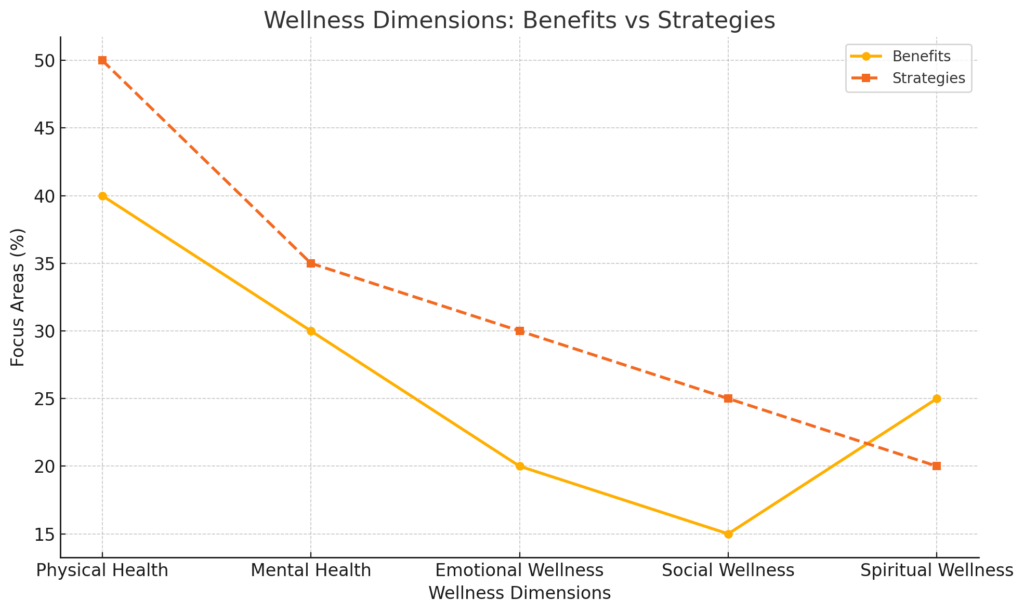Introduction
In today’s fast-paced world, wellness and health have become essential priorities for living a balanced and fulfilling life. These two interconnected concepts go beyond simply avoiding illness—they encompass physical fitness, mental well-being, emotional resilience, and spiritual harmony. By cultivating wellness and health in all aspects of life, you can unlock your full potential and experience a vibrant lifestyle.
This comprehensive guide will explore everything you need to know about wellness and health, from its key components to actionable strategies, expert advice, and emerging trends. Whether you’re starting your journey or looking to elevate your current practices, this guide will empower you to make informed decisions for your overall well-being.
Understanding Wellness & Health
1. What Is Wellness?
Wellness is a holistic approach to health that emphasizes balance and harmony across various dimensions of life. It involves:
- Physical Wellness: Maintaining a strong and healthy body through exercise, nutrition, and sleep.
- Emotional Wellness: Managing emotions effectively and maintaining mental clarity.
- Social Wellness: Building meaningful relationships and a supportive community.
- Spiritual Wellness: Finding purpose, meaning, and connection in life.
- Environmental Wellness: Creating a safe and sustainable environment that supports well-being.
2. What Is Health?
Health is often defined as the absence of illness, but it’s more than that. Health is about optimizing your physical, mental, and emotional states to perform at your best every day.
3. The Relationship Between Wellness & Health
Wellness and health are closely intertwined. While health focuses on the body’s physical state, wellness emphasizes a broader sense of well-being, including mental and social aspects. Together, they create a foundation for a thriving life.

The Key Components of Wellness & Health
1. Physical Health
- Regular Exercise: Engage in a mix of cardiovascular workouts, strength training, and flexibility exercises to keep your body strong and agile.
- Balanced Nutrition: Consume a diet rich in whole foods like vegetables, fruits, lean proteins, and healthy fats. Avoid processed and sugary foods.
- Adequate Sleep: Aim for 7–9 hours of quality sleep each night to support recovery and cognitive function.
2. Mental Health
- Stress Management: Practice techniques like mindfulness, deep breathing, or meditation to manage stress effectively.
- Therapy & Counseling: Seek professional help if you’re struggling with mental health challenges.
- Cognitive Stimulation: Engage in activities that challenge your mind, like puzzles, reading, or learning new skills.
3. Emotional Wellness
- Emotional Awareness: Recognize and accept your emotions without judgment.
- Building Resilience: Develop coping mechanisms to bounce back from setbacks.
- Fostering Gratitude: Practice daily gratitude to cultivate a positive outlook on life.
4. Social Wellness
- Strong Relationships: Invest in meaningful connections with family, friends, and colleagues.
- Community Engagement: Participate in local events or volunteer to foster a sense of belonging.
- Healthy Communication: Practice active listening and empathy to strengthen bonds.
5. Spiritual Wellness
- Reflection & Meditation: Take time to reflect on your values, goals, and purpose.
- Connection with Nature: Spend time outdoors to feel grounded and rejuvenated.
- Practicing Gratitude: Regularly express gratitude for the people and experiences that enrich your life.
The Benefits of Prioritizing Wellness & Health
Investing in wellness and health offers countless benefits, including:
1. Improved Physical Health
- Reduced risk of chronic diseases like heart disease, diabetes, and obesity.
- Increased energy levels and stamina for daily activities.
- Enhanced immune system function to ward off illnesses.
2. Better Mental Clarity
- Improved focus, concentration, and productivity.
- Reduced symptoms of anxiety and depression.
- Greater ability to manage stress and stay calm under pressure.
3. Emotional Resilience
- Increased ability to handle life’s challenges with grace and confidence.
- A more positive outlook on life, leading to greater happiness.
4. Stronger Relationships
- Building a supportive network of friends and loved ones.
- Feeling connected and valued within your community.
5. Longevity and Quality of Life
- Living longer, healthier, and more fulfilling years.
- Experiencing joy and satisfaction in both personal and professional endeavors.
Strategies for Achieving Wellness & Health
1. Develop a Personalized Wellness Plan
- Set Goals: Define what wellness and health mean to you and set specific, measurable goals.
- Track Progress: Use apps, journals, or trackers to monitor your habits and improvements.
- Adjust as Needed: Reassess your plan regularly to ensure it aligns with your evolving needs.
2. Prioritize Self-Care
- Dedicate time for activities that recharge and nourish you.
- Avoid overcommitting and learn to say no when necessary.
- Practice mindfulness and meditation to stay present and grounded.
3. Stay Active
- Incorporate movement into your daily routine, whether it’s walking, yoga, or weightlifting.
- Join group classes or fitness challenges to stay motivated and accountable.
- Explore outdoor activities to combine physical fitness with the benefits of nature.
4. Focus on Nutrition
- Prepare meals at home to control portions and ingredients.
- Hydrate consistently throughout the day.
- Eat a colorful variety of foods to ensure you’re getting all essential nutrients.
5. Build a Supportive Environment
- Surround yourself with people who uplift and inspire you.
- Create a home environment that promotes relaxation and wellness.
- Seek out wellness communities or online groups for guidance and motivation.
Emerging Trends in Wellness & Health for 2024
- Personalized Wellness Programs: Wearable technology and health apps offer tailored recommendations for fitness, sleep, and nutrition.
- Mental Health Focus: Wellness programs now prioritize mental health alongside physical fitness.
- Sustainability in Wellness: Eco-friendly products and practices are gaining popularity.
- Holistic Fitness: Practices like yoga and Pilates integrate physical and mental well-being.
- Virtual Wellness Solutions: Online classes, telemedicine, and virtual therapy sessions make wellness more accessible.
Overcoming Barriers to Wellness & Health
Common challenges include:
- Lack of Time: Schedule wellness activities as non-negotiable appointments.
- Limited Resources: Use free or low-cost tools, like home workouts or public parks.
- Low Motivation: Set small, achievable goals and celebrate progress along the way.
- Stress: Practice relaxation techniques like deep breathing or mindfulness.
Creating a Wellness Routine
- Morning Routine: Start your day with stretching, a healthy breakfast, and setting positive intentions.
- Midday Breaks: Incorporate light activity, like walking or desk yoga, to stay energized.
- Evening Relaxation: Wind down with a calming activity, like reading or meditation, to prepare for restful sleep.
Deepening Your Wellness & Health Practices
As you progress in your journey toward wellness and health, it’s important to continually explore new ways to deepen and refine your practices. Achieving balance in life is an ongoing process that requires adaptability, curiosity, and intentionality. By integrating advanced strategies and exploring lesser-known dimensions of wellness, you can elevate your quality of life and ensure that your well-being remains a priority.
1. Embracing Holistic Wellness
Holistic wellness involves addressing every aspect of your life to create a sense of balance and harmony. Beyond the physical and mental aspects, consider integrating spiritual and environmental wellness into your routine.
- Spiritual Wellness: Explore practices that align with your beliefs and values, such as meditation, journaling, or spending time in nature. Finding a deeper sense of purpose can help you stay grounded and focused.
- Environmental Wellness: Create a living space that supports your well-being by reducing clutter, incorporating natural elements, and choosing sustainable products. Your physical surroundings have a profound impact on your mental clarity and emotional stability.
By taking a holistic approach, you ensure that no aspect of your wellness journey is overlooked, allowing for more comprehensive and lasting improvements.
2. Exploring Advanced Nutrition Strategies
As you build a solid foundation in nutrition, you can enhance your health by incorporating advanced strategies tailored to your specific needs.
- Focus on Functional Foods: Include foods that provide additional health benefits, such as turmeric for its anti-inflammatory properties, or fermented foods like kimchi and yogurt for gut health.
- Cycle Nutrient Timing: For those who engage in regular physical activity, aligning your nutrient intake with your workout schedule can improve energy levels and recovery. For example, consuming protein-rich meals after exercise supports muscle repair.
- Experiment with Intermittent Fasting: This eating pattern has been shown to improve metabolic health and promote cellular repair. Consult a healthcare professional to determine if it’s right for you.
Advanced nutrition strategies allow you to fine-tune your diet and optimize your body’s performance and longevity.
3. Cultivating Mental Resilience
While physical health often takes the spotlight, mental resilience is equally vital for long-term wellness. Developing strong mental habits and coping mechanisms ensures that you can navigate life’s challenges with confidence and ease.
- Practice Cognitive Flexibility: Train your mind to adapt to new situations and think creatively by engaging in problem-solving activities or learning a new skill.
- Set Mental Boundaries: Protect your mental energy by saying no to activities or commitments that don’t align with your goals.
- Engage in Positive Visualization: Spend time imagining your ideal future and visualizing yourself overcoming challenges. This practice reinforces a growth mindset and keeps you motivated.
Building mental resilience not only supports emotional well-being but also enhances your ability to stay consistent with other aspects of your wellness journey.
4. Leveraging Social Support
Community and connection are powerful tools in your pursuit of wellness and health. Surrounding yourself with a supportive network can inspire, motivate, and keep you accountable.
- Join Wellness Communities: Whether online or in person, find groups that share your interests, such as yoga classes, book clubs, or hiking groups.
- Participate in Group Activities: Engaging in shared experiences fosters a sense of belonging and can make wellness practices more enjoyable.
- Communicate Openly: Build stronger relationships by expressing your needs and listening actively to others.
Strong social connections contribute to a sense of purpose and reduce feelings of isolation, both of which are essential for emotional well-being.
5. Staying Curious and Open-Minded
Finally, one of the most important ways to deepen your wellness and health journey is to remain curious and open to new ideas. Wellness is an evolving field, and there’s always something new to discover.
- Try Different Approaches: Experiment with new forms of exercise, meditation techniques, or dietary habits to see what resonates with you.
- Stay Informed: Keep up with the latest research and trends in wellness, and consult experts to ensure you’re making informed decisions.
- Reflect Regularly: Take time to evaluate what’s working for you and what isn’t, and adjust your strategies accordingly.
Curiosity keeps your wellness practices fresh and exciting, ensuring that your journey remains dynamic and fulfilling.
By integrating these advanced strategies into your routine, you can continue to grow and thrive in your pursuit of wellness and health. These practices allow you to create a balanced lifestyle that adapts to your needs, supports your goals, and enhances your overall sense of well-being.
Conclusion
Wellness and health are the foundation of a balanced and vibrant life. By prioritizing self-care, adopting healthy habits, and creating a supportive environment, you can achieve a sense of harmony and well-being that positively impacts every aspect of your life.
Take the first step today by integrating the principles of wellness and health into your routine. Your journey toward a more balanced, fulfilling life starts now.


